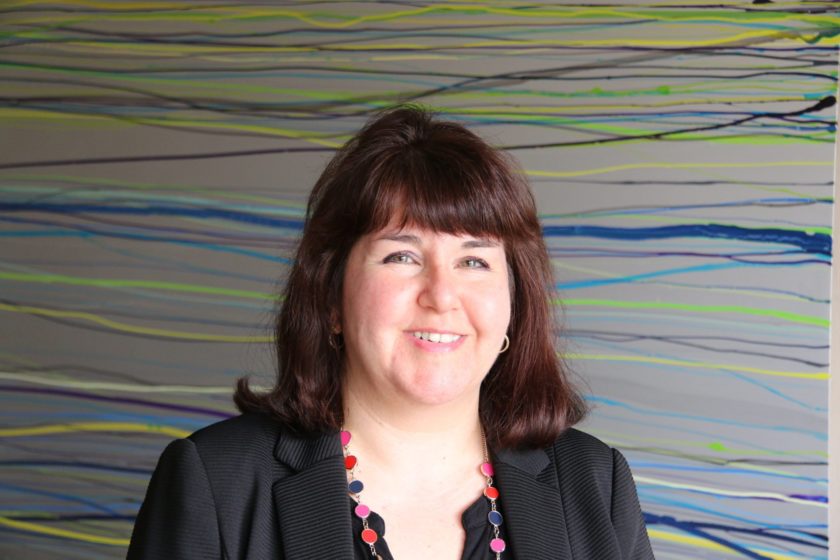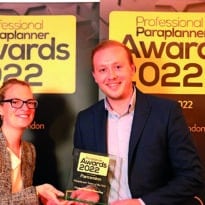Christina Georgiou, paraplanning manager at John Lamb, is not afraid to challenge the status quo, she tells PP editor Rob Kingsbury
If there is one thing that irks Christina Georgiou, paraplanning manager at John Lamb, about this industry it is compliance, notably its seeming inability to respond to the needs of a changing market, in effect its ‘stuck in the mud’ attitude.
“I know that is going to be seen as controversial but I see compliance lagging behind the rest of the market,” Christina says. “There is a lot of negativity around compliance. How often do you hear, ‘compliance won’t let us do it’? The industry is moving forward and I think compliance needs to come up with more innovative solutions to the issues we are facing and have a more collaborative attitude to finding solutions for clients.
“There are people in the industry like Phil Young of threesixty who I think are fantastic in the way they are trying to shift things along, but there are a lot of people out there who are far from helpful.
“They need to understand that times change and that people’s aspirations and needs are changing and we can no longer have a blanket approach to everything because that’s the way it’s been done. Even Rory Percival has criticised the way some compliance officers work.
“We need a different approach. We need to be a bit more open minded on things. We have an old fashioned industry but I think people are pushing against and challenging that now.”
The challenge to the status quo is often seen on Twitter, a vehicle that Christina is not averse to using. “I think people who use Twitter and other social media platforms are probably those who are more engaged and so willing to discuss and debate things, and also be more open to a little bit of criticism. We’ve seen some right ding-dongs happening but I think that is fantastic. I see that as improving communication and discussion, which can only be good for the market.
“I find it extremely positive that people are willing to speak up, as long as they realise that if you dish it out you have to be able to take it too,” she adds.
Over 25 years in the industry
So how did Christina get into the industry and become a paraplanner? Having graduated from the University of London with a degree in German Language and Literature, she started her working career at the Department of Trade and industry, as it was at the time. The pay structure, whereby everyone progressed up the pay scale over time regardless of their ability, was not where she wanted to be, she says, “I wanted to be rewarded based on my ability not because I turned up to the job every day” and she quit for a fast-track graduate scheme as a branch manager for the Woolwich. She stayed there for 11 years, mainly advising on mortgages, “which gave me a good grounding, as I went through training programmes and exams and most importantly, I was in front of people all day long, talking to them about their lives and their finances.”
Refused part-time work after having a baby if she wanted to stay as an authorised financial adviser, in February 2011 Christina moved to a small financial advice firm, Altorfer Financial Management, under the title financial adviser, “but really I was a paraplanner”, she says.
“Altorfer is a small practice in Waltham Abbey, intensely focused on its clients and its investment process, almost like a tiny DFM.” The difference in attitude between the large Woolwich, “where it was all about getting bums on seats, volumes and hitting targets” and the Altorfer was marked, Christina says. “It was small practice totally focused on what the client wants and needs. It was a forward thinking firm which had already got rid of initial charges and one of the first to use a wrap, but fiercely old-fashioned in the way clients should be treated. That was a thorough grounding for me in the financial advice world and set me on my path to where I am now.”
While there Christina was directly authorised, not to run a bank of clients but to act in the stead of the managing director of the firm when he was out of the office “so we could help any clients that rang in and needed answers to their question.”
Christina stayed with Altorfer for over nine years but was eventually drawn to City of London-based firms, working first at Weston Cummins, a broad-based advisory firm, as a paraplanner, where she stayed for close to three years before seeing a vacancy at John Lamb LLP, “which has a good reputation in the market” and securing the position of senior paraplanner. After what she refers to as “a minor blip” on her CV, when she moved to work with an old colleague “but it wasn’t the same and we didn’t gel like we had before”, she returned to John Lamb in February of this year, this time as the firm’s paraplanning manager.
Paraplanning manager
John Lamb has a total of 14 staff, five of which are advisers and there are five paraplanners including Christina.
Describing the role of paraplanning manager Christina says: “I’m still doing the paraplanning for one of the senior advisers but I’m also managing a team of four paraplanners. I’m responsible for the team, making sure the work gets done efficiently and in a timely manner.”
In addition, as part of the role, she is putting in place structures in terms of development and training for paraplanners in the firm and she reports to senior management on the productivity of the paraplanning team, the assets being accrued by the firm and, as each activity at the firm is time-cost measured, the fees that the team are capable of earning.
“It is not terribly complicated MI but it needed collating and a structure applied so the data was being produced in a more consistent manner. We are time costed, we all fill in time sheets for the work done, and we need to know which clients are profitable and if any are not profitable what we can do to help make them profitable.”
Christina is also looking at how new clients can be onboarded faster. “I’m looking at how we can improve our response times, through allocating the work more effectively, for example putting the person best qualified on each job and also better manage client expectations. It’s about seeing the bigger picture so that we’re improving the service to clients as well as running as a more efficient and profitable business.”
Speaking to clients
John Lamb paraplanners are very much encouraged to go to the client meetings, as part of a culture that wants paraplanners to speak to clients, Christina explains.
“Our managing director Paula Steele believes that is very important. I will do as many client meetings with advisers as they want me to and I will speak to clients before and after the meetings, whether or not I attend them.
“We are giving a bespoke, intensely focused service to clients and the client is paramount. It is just not acceptable to us that a client should phone in and be told the adviser isn’t available and a message will have to be got to him or her to phone back. It’s not something that is in the culture of John Lamb. There should be someone in the office that is able to help the client and give them an answer.
It works well for clients and enhances their experience of dealing with their financial adviser knowing they have support in the office that they can call upon and who won’t leave them hanging when they have a query.
“I don’t understand firms that won’t let their paraplanners talk to clients because they aren’t authorised. They say there is a risk involved but we’re all intelligent people and there is more risk that the clients will become disillusioned and go elsewhere. In fact, I wouldn’t be able to work anywhere where the paraplanners were kept at arms length from the clients.”
Christina sees cashflow planning as increasingly important to clients – even the very wealthy “who often can’t see whether they have enough to see them through until you show it to them on a cashflow chart”.
“Cashflow is so visual and seeing it in that way is refreshing for the client and just makes it so much simpler when trying to get the message across.”
Getting the best from an adviser
Diploma qualified at present, Christina is currently working towards chartered status but says she draws on her plus 25 years in the industry every day. So, given her experience, I ask how she works with and gets the best out of her advisers.
“This is where communication is so important. It’s also where I see paraplanners come unstuck. Everyone wants to be briefed properly by an adviser but you need to have a bit of lateral thinking as advisers have a different mindset to us. They are interested in how much business and income they can generate. So they are not always going to give a paraplanner the type of thorough briefing they would want. It’s important that the paraplanner recognises that and works with that in mind.
“One of the best ways I’ve found to work with it is to write down all the things I need and go to the adviser and say ‘This is what I need and I can’t shift your work on and get this business on the books until you give me that information’. That appeals to the adviser mindset. It’s also showing that as a paraplanner I am working with them to the same end.”
“What you don’t want to happen is for the paraplanner to be seen as someone who is always interrupting to ask questions because that’s when you can get friction building up.
What you have to remember is that there may be a paraplanning team and an adviser team but the bigger picture is that we’re all on the same team, the business team.
“At John Lamb everyone sits together, which I think is a really good working practice because it makes for better communication between us all.
“We look for reasons to do the work not reasons not to do the work. It’s a different attitude and it’s what makes for a successful business.”
Getting the best from the team
What about getting the best from her team? “It’s communication again. I have very high standards and people know what I want to see because I’m very communicative; I talk to people about everything. I’m also part of the team. You need to be a team worker as well as team builder. I still write reports, work from templates and I still need help from other people. I’m in the mix all the time.
“It’s also about being honest with people. Occasionally you need to lay down the law but for me it’s about treating people how you want to be treated yourself. I don’t want to be spoken to in a condescending or aggressive manner and I don’t talk to other people like that.”
Christina is a member of the Paraplanning Standard committee. See her views on the Standard on the Professional Paraplanner website
What’s a typical working day for Christina?
Every morning I start with two cups of tea, with two teabags in each. I can’t get on with anything until I’ve had my tea.
Then I’ll check my email to see what may have come in overnight and I’ll take 10-15 minutes to prioritise my day. I split my day into time blocks as far as I can. If I have reports to do, I’ll tackle them first, if I have something structural or data work on the paraplanning function I’ll allocate part of my day to it.
Because we all work together there is a flow throughout the office, which can take you away from your planned day at times but we time record everything.
My day is a combination of paraplanning – writing reports, helping advisers prepare for meetings, possibly attending a meeting and doing the pre and post meeting work – alongside structural work, and training and developing of the team.
While I structure my day, there are times when I feel I’ve got a huge amount done and other days when I think, ‘where did the time go?’. That’s all part of the ebb and flow of paraplanning.





























